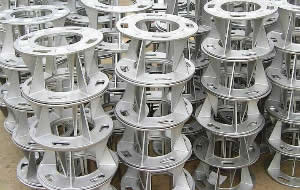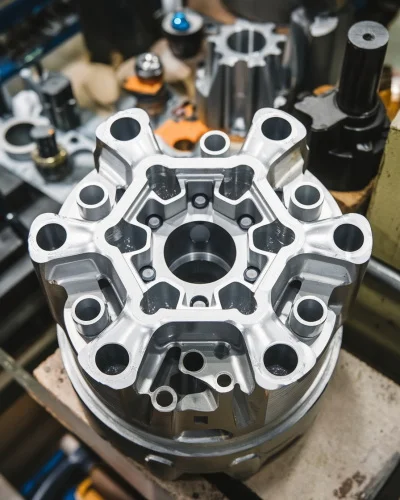Why Precision aluminum casting is preferred for lightweight metal solutions
Comprehending the Ecological Advantages of Light Weight Aluminum Foundry Techniques
Light weight aluminum foundry strategies play a vital role ahead of time sustainability within the manufacturing sector. By carrying out advanced recycling techniques and energy-efficient methods, these techniques significantly decrease waste and carbon footprints. Ingenious spreading techniques further enhance source conservation efforts. As markets significantly focus on environmental responsibility, comprehending the full impact of these methods comes to be essential. What specific advancements are leading the means in this makeover?
The Duty of Aluminum in Lasting Production
Numerous products add to lasting production, light weight aluminum stands out due to its unique properties and recyclability. This light-weight metal is not only durable however also possesses superb corrosion resistance, making it a perfect choice for numerous applications, from auto to building. Its high strength-to-weight proportion causes power savings during transport and use. Additionally, light weight aluminum can be recycled forever without shedding its intrinsic top qualities, advertising a round economic climate.
The manufacturing procedure of aluminum has developed, integrating energy-efficient methods that lower carbon impacts. By utilizing renewable power sources, manufacturers are significantly minimizing the ecological effect related to aluminum manufacturing. Additionally, using recycled light weight aluminum needs significantly less energy contrasted to removing and improving main light weight aluminum, bring about reduced greenhouse gas exhausts. As markets seek lasting solutions, aluminum's versatility and eco-friendly attributes placement it as a critical material in the quest of greener production methods.
Advanced Recycling Techniques in Aluminum Foundries
Advanced recycling strategies in light weight aluminum foundries are changing the means scrap aluminum is refined and recycled. Innovative methods, such as closed-loop recycling systems, make it possible for shops to reclaim light weight aluminum from production waste and out-of-date products effectively. These systems decrease worldly loss and improve the top quality of recycled light weight aluminum, making it a practical option to key light weight aluminum production.
Furthermore, progressed arranging technologies, consisting of automated optical sorting and X-ray fluorescence, boost the splitting up of light weight aluminum from other products, ensuring greater pureness degrees in recycled outcomes. This precision decreases contamination, which can compromise the integrity of the end product.
Furthermore, the integration of advanced melting modern technologies, such as induction melting and energy-efficient heating systems, simplifies the reusing process, decreasing energy intake. Jointly, these technologies contribute to a more sustainable light weight aluminum market by reducing dependence on virgin products and decreasing greenhouse gas discharges related to light weight aluminum production.
Power Performance Improvements in Foundry Procedures
Power performance enhancements in aluminum factory operations can substantially improve sustainability practices. Carrying out waste heat recuperation systems allows foundries to repurpose excess energy, reducing total power usage. Additionally, innovations in procedure automation improve operations, causing reduced waste and optimized source use.
Waste Heat Healing
Executing waste warm healing systems in light weight aluminum shops substantially improves power performance by recording and recycling excess thermal energy generated throughout manufacturing procedures. These systems assist in the conversion of lost heat into usable power, which can be utilized for various applications within the factory, such as preheating products or powering tools. By recouping warmth that would certainly otherwise be eliminated right into the environment, shops can substantially reduce their total energy intake and greenhouse gas emissions. This technique not only decreases operational prices but also promotes lasting techniques within the market. Additionally, the adoption of waste warm healing technologies straightens with governing standards focused on minimizing ecological effect, making it an essential element of modern light weight aluminum foundry operations.
Process Automation Advantages
Automating processes in light weight aluminum factories can greatly improve power effectiveness by optimizing production operations and minimizing waste. By implementing sophisticated innovations such as robotics and device learning, shops can streamline procedures, minimizing unneeded power consumption. Automated systems help with accurate control over temperature and product handling, making sure that power is utilized only when needed. Additionally, real-time tracking enables for prompt modifications, lowering the risk of power loss. The assimilation of automation not only boosts productivity yet also lowers functional expenses, making factories more competitive. Because of this, these energy-efficient techniques contribute substantially to sustainability objectives, decreasing the environmental impact of aluminum production while meeting boosting market demands - Aluminum Casting Company. Enhanced energy effectiveness via automation represents an important action towards greener foundry procedures
Minimizing Waste Via Cutting-edge Casting Approaches
Ingenious casting methods play a necessary role in reducing waste in aluminum factories. Techniques such as advanced molding and the usage of recyclable products greatly reduce check out this site manufacturing scrap. These methods not only enhance performance however additionally add to a more sustainable manufacturing procedure.
Advanced Molding Techniques
As sectors progressively focus on sustainability, advanced molding methods in light weight aluminum shops become effective solutions for decreasing waste. These cutting-edge methods, such as 3D printing and precision mold production, significantly improve the performance of the casting procedure. By using computer-aided layout (CAD) and simulation innovations, suppliers can maximize mold and mildew geometry, minimizing material use while maintaining product stability. In addition, advanced techniques enable the production of intricate shapes that typical techniques can not achieve, reducing the demand for extra machining and thereby reducing scrap material. The flexibility of these methods allows for quick prototyping, further lowering lead times and energy intake. In general, the execution of advanced molding techniques stands for an important step toward ecologically accountable aluminum production, aligning with global sustainability goals.
Recyclable Material Application
Recyclable materials play an essential duty in decreasing waste within light weight aluminum shops, transforming the spreading landscape through their efficient use. By integrating scrap aluminum and other recyclable components into the manufacturing process, foundries can considerably lower the demand for virgin products. This not only saves natural deposits but additionally lessens power usage linked with mining and refining. Cutting-edge casting methods, such as die spreading and sand casting, enable smooth combination of these products, guaranteeing top notch results. Moreover, making use of recyclable products promotes a circular economic climate, where sources are consistently reused and repurposed, decreasing land fill payments. Inevitably, the strategic usage of recyclables enhances sustainability while advertising cost-effectiveness in light weight aluminum foundry operations.
Reducing Manufacturing Scrap

Life Process Evaluation of Light Weight Aluminum Products
Although aluminum is extensively recognized for its lightweight and durable homes, a comprehensive Life process Evaluation (LCA) exposes the environmental impacts associated with its disposal, use, and manufacturing. The LCA process takes a look at the power intake, greenhouse gas discharges, and source exhaustion connected to light weight aluminum items from removal of bauxite ore to end-of-life administration. Primary light weight aluminum production is energy-intensive, often relying upon nonrenewable fuel sources, which adds significantly to carbon footprints. In comparison, recycling aluminum offers considerable ecological benefits, as it utilizes just a portion of the power required for primary manufacturing. In addition, the recycling procedure decreases landfill waste and preserves natural deposits. The LCA likewise thinks about the product's longevity and potential for reuse, emphasizing the significance of sustainable design. On the whole, recognizing the life process effects of light weight aluminum products is crucial for making informed choices that prioritize environmental sustainability within the sector.
Situation Studies: Effective Lasting Practices in the Industry
The light weight aluminum sector has started to accept innovative lasting methods that deal with the environmental difficulties identified in Life Cycle Assessments. One noteworthy case is a leading shop that executed a closed-loop recycling system, significantly click for source reducing waste and power usage. By recycling scrap light weight aluminum in production, the facility attained a 40% reduction in its carbon footprint.
An additional example involves a maker that adopted renewable resource sources, powering its operations with solar and wind power - Aluminum Foundry. This change not just reduced greenhouse gas emissions however also boosted the company's online reputation among ecologically conscious customers
In addition, a 3rd foundry has spent in innovative casting techniques, which optimize product use and lessen flaws, further lowering source consumption. These study highlight that the light weight aluminum industry is capable of integrating lasting practices, showing both environmental duty and economic viability, inevitably adding to an extra lasting future.
Frequently Asked Questions
Just How Does Aluminum Compare to Other Steels in Sustainability?
Light weight aluminum is normally considered more sustainable than lots of metals as a result of its recyclability, lower energy requirements for manufacturing, and minimized environmental impact. Its lifecycle effectiveness goes beyond that of steel and copper in various important site applications.
What Is the Carbon Footprint of Light Weight Aluminum Shop Processes?
The carbon footprint of light weight aluminum factory processes varies, typically varying from 4 to 15 statistics lots of carbon dioxide per ton of aluminum created. Elements influencing this include power resources, innovation, and the effectiveness of procedures.
Exist Health And Wellness Risks Connected With Light Weight Aluminum Factory Operations?

What Are the Expenses Connected With Lasting Light Weight Aluminum Techniques?
The prices related to sustainable light weight aluminum strategies include higher first investments in modern technology, potential increases in operational expenditures, and continuous upkeep. Nonetheless, these are typically offset by lasting cost savings and minimized environmental effect.
How Does Aluminum Recycling Effect Citizen Communities?
Aluminum recycling positively impacts local neighborhoods by creating tasks, decreasing landfill waste, and reducing energy costs. It cultivates economic development and promotes environmental stewardship, bring about healthier living problems and improved neighborhood engagement in sustainability efforts.
In addition, the usage of recycled light weight aluminum needs substantially much less energy contrasted to drawing out and improving key light weight aluminum, leading to lower greenhouse gas discharges. Advanced recycling strategies in light weight aluminum shops are revolutionizing the means scrap aluminum is refined and reused. Aluminum Casting Company. Executing waste heat recuperation systems in aluminum foundries substantially boosts power effectiveness by recording and recycling excess thermal energy produced during production processes. Automating procedures in light weight aluminum factories can significantly improve power effectiveness by maximizing manufacturing operations and minimizing waste. The carbon footprint of light weight aluminum factory procedures varies, typically varying from 4 to 15 metric loads of Carbon dioxide per bunch of light weight aluminum generated